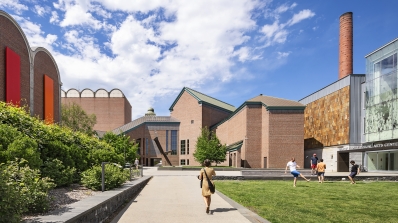Exhibitions Archive
Joan Miro and Dorothea Tanning's Surrealist Exlporations of the Unconscious
Discovering Identity Through ArtIcons of the 1960's
Ruscha and Pop
Highlights from the Hood's pop art collection reveal the intersection between life and art through the appropriation of media, commercial, and popular culture imagery. Focused around Ed Ruscha's Standard Station, Amarillo, Texas (1963), Ruscha and Pop explores aspects of pop art including the transformation of the everyday object into art, the popular interest in consumerism and commercial architecture, and the collapsing of boundaries between high and low art and culture. The charged cultural environment of the 1960's fills the work of first-generation pop icons including Ed Ruscha, Andy Warhol, and Roy Lichtenstein, as well as artists immediately following them, including Mel Ramos and Stephen Shore.
Photographic Memoirs of an Aboriginal Savant
Hulleah J. Tsinhnahjinnie
Contemporary Seminole artist Hulleah J. Tsinhnahjinnie's photographs respond to the perpetuating stereotypes of Native American peoples caused by ubiquitous early Western photography of Native people fixed in a historical past. Looking inward to document moments and thoughts about childhood and family, high school, friends, particular experiences, and dreams, she delivers a deeply moving installation that comprises a strong political statement about Native sovereignty and cultural oppression intermixed with poignant storytelling and personal convictions.
The Aftermath of the War Between the States in Consumer-Driven Art
"Bringing the Thing Home"A History of Viewing from the Renaissance to the Present Day
The Art of Spectatorship
This companion to the course Introduction to Art History II focused on five topics- devotional images, artistic presence in a work of art, voyeurism and the female nude, portrayals of social class and conflict, and artistic quotation and appropriation-surrounding the changing experience of viewing art from the Renaissance to the present day. Images such as Saint Veronica's Sudarium (about sixteenth century), which presents the miraculous transference of Christ's image to Veronica's handkerchief upon route to the crucifixion, appeared alongside Dana Salvo's Mendoza Household Shrine (about 1995), a photograph of a homemade altar with plastic fruits and artificial lights. Other groupings included images of nude classical goddesses and Reginald Marsh's mid-twentieth-century tempera paintings of a New Jersey striptease. Depictions of class convergence in city streets by artists ranging from Honore Daumier to John Sloan further explored the exhibition's themes.
